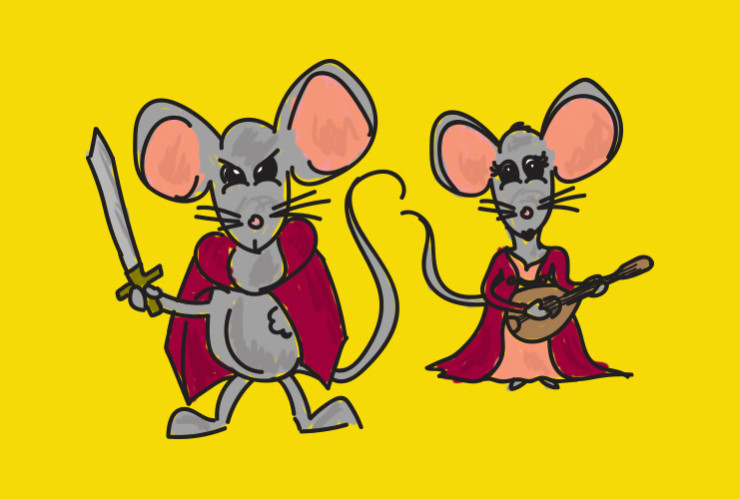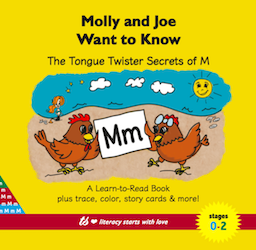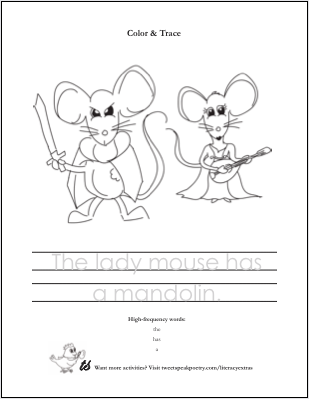Now, you can help a child learn to read with the young chickens Molly and Joe—two wide-eyed early readers who are full of curiosity, mischief, and mirth—plus, in this fun M edition, characters like a mare, monkeys, medieval mice, and a mermaid! Rich language and amusing illustrations combine with strategies that address how the brain remembers best: pattern, repetition, visual novelty, and multi-sensory experiences.
Children demonstrate six reading stages, from zero to five (print awareness to analysis and reasoning). This multi-level Molly and Joe Want to Know reader serves stages zero to two: print awareness, sound and letter pairing, and automatic reading.
You can use the Reader to read for pleasure (even for babies!); then teach the letter m; then teach or reinforce other sound/letter relationships, high-frequency words, new vocabulary, and writing.
In a move-quickly-from-one-thing-to-the-next culture, it can be surprising to learn that stage two learners benefit from repeated experience with the same texts and materials, until reading is automatic.
To make the necessary repetition easy and fun, we’ve included simple games with cut-out materials (all reusable) and activities in the Reader. You’ll find Color & Trace Pages, Merry-Go-Round Matching, Story Cards (for Matching, Story Train, Partners in Rhyme, and Story Challenge games), Letter Dress-Up Cards (for sound and letter associations and word building), and Sentence Builders.
Color and Trace “The Lady Mouse Has a Mandolin”
Download Free Coloring Page
Our Color & Trace pages help teach high-frequency words, develop fine motor skills and handwriting, and solidify memory of the letter m or other sound/letter relationships.
So maybe you’re looking for extra, fun reading activities to support the learn-to-read journey. To that end, we’re sharing: “The Mouse Has a Mandolin.” If you’ve already got the Molly and Joe reader, then you have other fun coloring pages that teach high-frequency words.
5 Fun Facts About Mandolins
1. It’s easy to think the mandolin, with its neck and strings, is part of the guitar family. But it is actually part of the lute family, which originated as far back as 3,000 BC. The 8-string mandolin first appeared in Italy in the 16th and 17th centuries, though its predecessor was popular in the Middle Ages.
2. We’re thinking mandolins might have been a popular place for mice to hide. There’s an old story that musician Bill Monroe, who is known as the Father of Bluegrass, used to keep a rattlesnake tail inside his mandolin to frighten the mice away.
3. The swirled shape of the openings in a mandolin’s body are known as f-holes, shaped like a letter F. The use of the letter F might also be because they were first used by mandolin makers in Florence, Italy.
4. Like the violin family, the mandolin family has instruments of varying size and sound quality. The mandolin is the soprano member, while there is an alto (mandola), tenor (octave mandolin), bass or baritone (mandolone or mandocello), among others.
5. Despite its popularity since Medieval times, the mandolin can be found in all kinds of music, from bluegrass to country to classical, folk and even rock and roll.
Enjoy this fun video about mice and mandolins
This video is the very first Merry Melodies cartoon from 1931, called “Lady, Play Your Mandolin!”
Mandolin Limerick Poetry Prompt
Try your hand at a limerick about mandolins and mice. Use the “fun facts” as inspiration if you like. Need more inspiration? Check out our limerick infographic.
This book is so much fun! I used it with about 10 Kindergarten and first graders who are labeled as “at-risk,” (I like to call them my promising students), and we had a blast reading the poem and doing the activities. The poem produces giggles and conversation, and the activities are easy to prepare and fun to complete! Plus, I love that I can use the activities over again. This is a must have in a teacher’s classroom.
—Callie Feyen, at-risk literacy specialist
- Earth Song Poem Featured on The Slowdown!—Birds in Home Depot - February 7, 2023
- The Rapping in the Attic—Happy Holidays Fun Video! - December 21, 2022
- Video: Earth Song: A Nature Poems Experience—Enchanting! - December 6, 2022



Bethany R. says
I love seeing these playful readers being published. 🙂